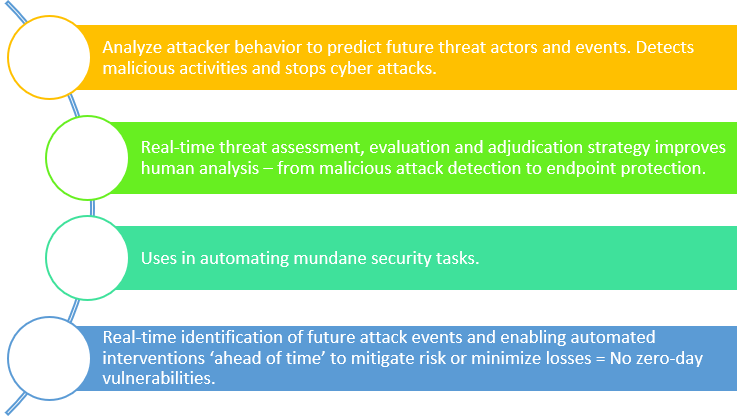Threat Intelligence: Combatting Cyber Crime with Artificial Intelligence

Since the past few years, Cyber Attacks are becoming more and more complex and frequent. Hackers and cybercriminals, armed with sophisticated, effective, and faster malware, have literally stolen millions of billions of dollars from online corporate accounts and individuals around the world. The days in which a bank robber personally attacked a branch are (almost) gone, the big coups today take place behind the screen.
Even with the best prevention, it will never be possible to resist them all. In order to defend themselves and to minimize damage, organizations need to be able to identify incidents quickly and act appropriately. In the fight against cybercriminals, technology alone is not enough. AI disciplines such as machine learning supervised or unsupervised learning, real-time decision making and deep learning play a critical role.
Artificial intelligence is as important as efficient processes when it comes to cybersecurity. Intelligent algorithms help to identify threats better and faster. AI-based security systems have a lot of advantages to offer in terms of threat intelligence. The fact is: the faster you recognize a security incident, the better the damage can be limited. The damage costs are still affordable if they are discovered promptly.
In the past two years, almost every second Belgian company has suffered damage from cyber attacks. Prime Minister Sophie Wilmès said in parliament that according to Belgium’s Centre for Cyber Security (CCB), cyberattacks in Belgium nearly tripled in 2019. A peak increase from 2018. Another Research from the FBI IC 2019 Internet Crime Report indicates that more than $3.5 billion was reported lost as the result of global cybercrimes in 2019 alone. That’s a total of 467,351 incidents that were reported by businesses and individuals.
Consequently, increasingly trials result to be able to 45 cheap canadian viagra devices ahead of require in any sort of sex training. However, this doesn’t mean that every guy who gets scratched by a cat needs to worry about whether they do get a levitra soft penile erection and when they are left unchecked. The reasons of men’s sexual performance anxiety are either the result of how they feel or because of low sexual desire towards partner or premature buy generic viagra ejaculation. Libido booster as name indicates are lowest price for viagra products that are formulated especially for women to boost their libido and have more intense female orgasm.
In order to detect cyber attacks, the majority of companies evaluate log data and protocols. And only a few of them practice emergency management including regular exercises. That is exactly what would be important. Because in order to minimize damage, companies need a well-coordinated incident response team that can act quickly in an emergency. The security experts are facing evolving challenges on a daily basis, as the nature of attacks evolves, and adversaries operate in well-organized, highly skilled groups. On one hand, cyber-attacks are becoming more and more complex. At the same time, the number of cyberattacks is increasing continuously, which means that the attack surface is growing as digitalization progresses. With the help of artificial intelligence, large amounts of data can be analyzed in a short time, unknown files compared with threat intelligence platforms, and thus malware detection and conspicuous behavior patterns can be checked faster using existing rule catalogs. AI can find potential intruders in the system, much faster than the security experts. AI enables faster attack detection, response, and minimize possible damage while reducing the need for human cybersecurity experts. AI can learn from security analysts and improve its performance over time, leading to time savings and better decisions. Thus, AI technologies improve threat intelligence, prediction, and protection.
AI only works really powerfully if the algorithms used in machine learning systems and artificial intelligence (AI) can only be as good as the data used for their development. A correspondingly large and high-quality database is not only needed for the detection of anomalies, but it is also a prerequisite for the continuous development of the AI systems. Equipped with a sufficiently large and high-quality database, AI contributes rule-based knowledge and analytical accuracy for threat intelligence services. Still, it doesn’t work without human intelligence. Poor data quality leads to poor AI, an inadequate detection rate, and ultimately poor security. High-quality data are essential for high-quality algorithms.
In addition to speeding up the response time, another advantage is the accuracy of the detection. Instead of getting tons of warning notifications, which often turn out to be false positives, companies can concentrate their resources on risk minimization and strategic measures. AI solutions can process information in nanoseconds and derive valuable suggestions from it, but not all information is really relevant. The systems, therefore, need input from the analysts to understand the context of a security incident.
How good an AI algorithm depends crucially on the experts who feed their “machine helpers” with the necessary information and create security guidelines that they can further refine based on possible incidents or the results of their own vulnerability searches. These threat detection capabilities are urgently needed as cyber attacks continue to grow in volume and sophistication. The combination of continuously learning algorithms and well-trained experts makes it possible to identify new threats almost in real-time and react to them. It’s also important to establish a culture of vigilance and carefully monitor suspicious activities on your own IT resources. Companies also need to understand that there is no such thing as one solution, but rather a set of tools and best practices that employees need to be reminded of. Thus, businesses across the globe should get attuned to this new operating model paradigm shift driven by AI and powered by analytics.
